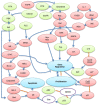Gene Networks and Pathways Involved in LPS-Induced Proliferative Response of Bovine Endometrial Epithelial Cells
- PMID: 36553609
- PMCID: PMC9778113
- DOI: 10.3390/genes13122342
Gene Networks and Pathways Involved in LPS-Induced Proliferative Response of Bovine Endometrial Epithelial Cells
Abstract
Lipopolysaccharide (LPS) is a component of the outer membrane of Gram-negative bacteria involved in the pathogenic processes leading to mastitis and metritis in animals such as dairy cattle. LPS causes cell proliferation associated with endometrium inflammation. Former in vitro studies have demonstrated that LPS induces an intense stimulation of the proliferation of a pure population of bovine endometrial epithelial cells. In a follow-up transcriptomic study based on RNA-sequencing data obtained after 24 h exposure of primary bovine endometrial epithelial cells to 0, 2, and 8 μg/mL LPS, 752 and 727 differentially expressed genes (DEGs) were detected between the controls and LPS-treated samples that encode proteins known to be associated with either proliferation or apoptosis, respectively. The present bioinformatic analysis was performed to decipher the gene networks involved to obtain a deeper understanding of the mechanisms underlying the proliferative and apoptosis processes. Our findings have revealed 116 putative transcription factors (TFs) and the most significant number of interactions between these TFs and DEGs belong to NFKβ1, TP53, STAT1, and HIF1A. Moreover, our results provide novel insights into the early signaling and metabolic pathways in bovine endometrial epithelial cells associated with the innate immune response and cell proliferation to Escherichia coli-LPS infection. The results further indicated that LPS challenge elicited a strong transcriptomic response, leading to potent activation of pro-inflammatory pathways that are associated with a marked endometrial cancer, Toll-like receptor, NFKβ, AKT, apoptosis, and MAPK signaling pathways. This effect may provide a mechanistic explanation for the relationship between LPS and cell proliferation.
Keywords: RNASeq; bovine endometrium epithelial cells; cell proliferation; lipopolysaccharide.
Conflict of interest statement
The authors declare no conflict of interest. The funders had no role in the design of the study; in the collection, analyses, or interpretation of the data; in the writing of the manuscript; or in the decision to publish the results.
Figures



 ) show DEGs in our RNASeq reads. The red font in the figure shows tumor suppressor genes.
) show DEGs in our RNASeq reads. The red font in the figure shows tumor suppressor genes.
Similar articles
-
Changes in protein expression profiles in bovine endometrial epithelial cells exposed to E. coli LPS challenge.Mol Biosyst. 2017 Jan 31;13(2):392-405. doi: 10.1039/c6mb00723f. Mol Biosyst. 2017. PMID: 28070584
-
LPS-treatment of bovine endometrial epithelial cells causes differential DNA methylation of genes associated with inflammation and endometrial function.BMC Genomics. 2020 Jun 3;21(1):385. doi: 10.1186/s12864-020-06777-7. BMC Genomics. 2020. PMID: 32493210 Free PMC article.
-
Differential gene expression in bovine endometrial epithelial cells after challenge with LPS; specific implications for genes involved in embryo maternal interactions.PLoS One. 2019 Sep 5;14(9):e0222081. doi: 10.1371/journal.pone.0222081. eCollection 2019. PLoS One. 2019. PMID: 31487323 Free PMC article.
-
Global transcriptomic profiling of bovine endometrial immune response in vitro. I. Effect of lipopolysaccharide on innate immunity.Biol Reprod. 2015 Oct;93(4):100. doi: 10.1095/biolreprod.115.128868. Epub 2015 Sep 9. Biol Reprod. 2015. PMID: 26353891
-
Docosahexaenoic acid attenuates LPS-stimulated inflammatory response by regulating the PPARγ/NF-κB pathways in primary bovine mammary epithelial cells.Res Vet Sci. 2017 Jun;112:7-12. doi: 10.1016/j.rvsc.2016.12.011. Epub 2017 Jan 5. Res Vet Sci. 2017. PMID: 28095338 Review.
Cited by
-
Population characteristics of pathogenic Escherichia coli in puerperal metritis of dairy cows in Ningxia region of China: a systemic taxa distribution of virulence factors and drug resistance genes.Front Microbiol. 2024 Apr 17;15:1364373. doi: 10.3389/fmicb.2024.1364373. eCollection 2024. Front Microbiol. 2024. PMID: 38694808 Free PMC article.
-
Cytochalasin B Mitigates the Inflammatory Response in Lipopolysaccharide-Induced Mastitis by Suppressing Both the ARPC3/ARPC4-Dependent Cytoskeletal Changes and the Association Between HSP70 and the NLRP3 Inflammasome.Int J Mol Sci. 2025 Mar 26;26(7):3029. doi: 10.3390/ijms26073029. Int J Mol Sci. 2025. PMID: 40243637 Free PMC article.
References
-
- Guo Y., Van Schaik T., Jhamat N., Niazi A., Chanrot M., Charpigny G., Valarcher J.F., Bongcam-Rudloff E., Andersson G., Humblot P. Differential gene expression in bovine endometrial epithelial cells after challenge with LPS; specific implications for genes involved in embryo maternal interactions. PLoS ONE. 2019;14:e0222081. doi: 10.1371/journal.pone.0222081. - DOI - PMC - PubMed
-
- Cronin J.G., Turner M.L., Goetze L., Bryant C.E., Sheldon I.M. Toll-like receptor 4 and MYD88-dependent signaling mechanisms of the innate immune system are essential for the response to lipopolysaccharide by epithelial and stromal cells of the bovine endometrium. Biol. Reprod. 2012;86:51–59. doi: 10.1095/biolreprod.111.092718. - DOI - PMC - PubMed
Publication types
MeSH terms
Substances
LinkOut - more resources
Full Text Sources
Research Materials
Miscellaneous

